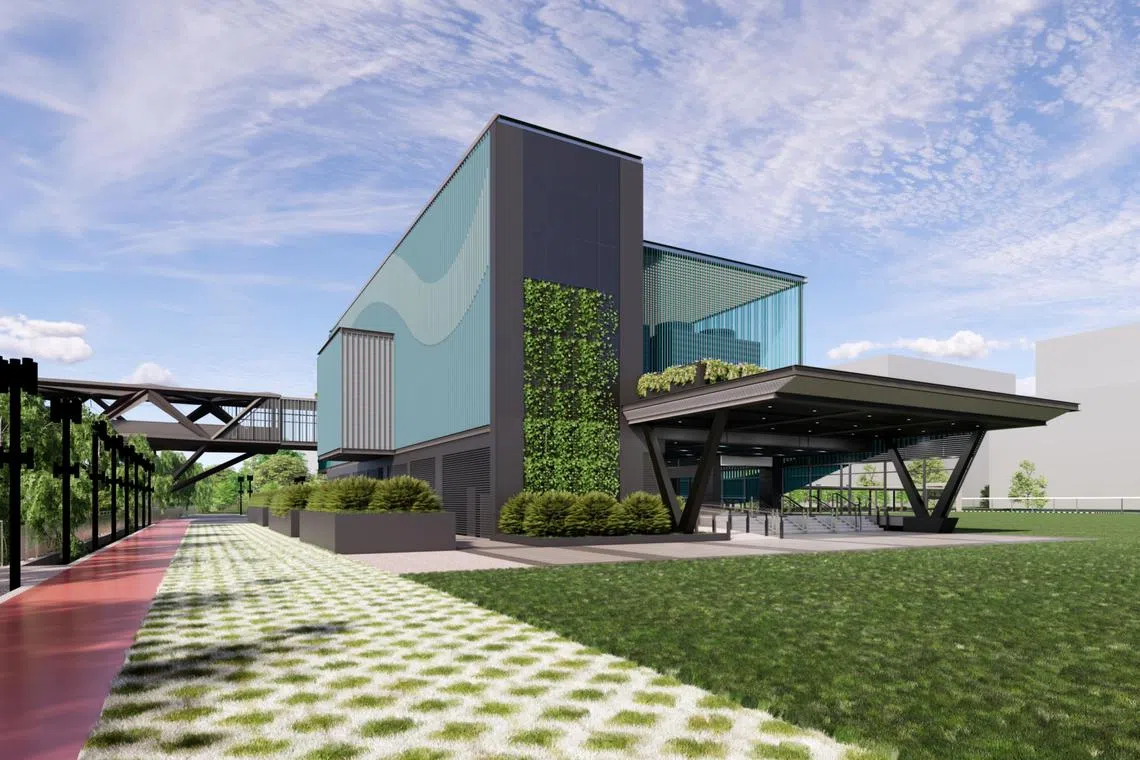DTL extension to Sungei Kadut to open in 2035, including new MRT station near Yew Tee Village
Sign up now: Get ST's newsletters delivered to your inbox

An artist's impression of the new station codenamed DE1, which will be located near the Rail Corridor.
PHOTO ILLUSTRATION: LTA
Follow topic:
SINGAPORE - A new underground MRT station will be built near Yew Tee Village as part of a planned extension of the Downtown Line (DTL) from Bukit Panjang to Sungei Kadut.
When it is completed, travel time to downtown areas such as Chinatown is expected to be cut by 20 minutes.
The 4km DTL extension will also include a new interchange with the North-South Line (NSL) in Sungei Kadut Central.
The stations will open in 2035, with construction to start by the fourth quarter of 2025, the Land Transport Authority (LTA) said in a statement on Jan 6.
The first new station on the DTL extension after the current terminus in Bukit Panjang will be in Sungei Kadut Avenue, on industrial land owned by government agency JTC Corporation that is slated to undergo future development.
Codenamed DE1, the station will be located near the Rail Corridor, and will be connected to Yew Tee Village
Yew Tee Village refers to the housing estate around Choa Chu Kang Drive and Choa Chua Kang Crescent.
A dual two-lane vehicular bridge, as well as access roads, will be built to connect the new MRT station with Choa Chu Kang North 7 and Woodlands Road. Covered linkways and cycling paths will also be constructed to improve first- and last-mile connectivity.

An artist’s impression of a covered linkway from the vehicular bridge to DE1 station.
PHOTO ILLUSTRATION: LTA
Farther north, the new interchange in Sungei Kadut Central will serve as the new terminus for the DTL.
The DTL station, codenamed DE2, will be built underground, and will link to a new above-ground NSL station, NS6, between the existing Yew Tee and Kranji stations.
The interchange will serve the upcoming Sungei Kadut Eco-District, a 500ha industrial estate being developed by JTC as part of longer-term plans by the Ministry of Trade and Industry to revamp one of Singapore’s oldest industrial estates.

An artist’s impression of a covered linkway going towards DE1 station.
PHOTO ILLUSTRATION: LTA
The new above-ground station in Sungei Kadut will be built on top of existing MRT viaducts, with some modifications. This is similar to how the NSL’s Canberra station was constructed.
As the interchange will also be built on JTC’s turf, there will be no need for LTA to acquire private land for the rail extension.
Still, existing industrial buildings in Woodlands Road, Sungei Kadut Avenue, Sungei Kadut Way, and Sungei Kadut Streets 1 and 2 will need to be demolished.
In response to queries, JTC said most of the land that LTA needs is already vacant, and it is helping to facilitate the relocation of eight remaining companies that will leave when their leases expire.
This will be before construction starts in late 2025.
Asked about the location of the new stations and why it will take 10 years to build them, LTA said it worked with various government agencies to determine the most optimal alignment, taking into account technical feasibility, existing and future developments, as well as biodiversity-sensitive sites.
LTA said the construction duration is heavily affected by many factors, including the scale and complexity of design. It also pointed to environmental and site constraints on working near Pang Sua Canal and the Rail Corridor.
Given the proximity of the DTL extension to the Rail Corridor, which serves as a key ecological corridor between major green spaces and forest habitats in Singapore, an environmental study was done from 2021 to 2023, in consultation with nature groups.
The relevant reports have been published on LTA’s website, with the public asked to provide feedback by Feb 3.
LTA said measures will be taken to minimise the environmental impact of the works, including providing a 30m-wide wildlife passageway along the Rail Corridor during construction.
With these measures, the environmental study found that the construction and operation of the rail extension would have negligible to minor impact on biodiversity in the surrounding area.
But vibrations due to tunnelling work could still have a moderate impact on fauna, such as the nationally endangered mud lobster, though this is expected to be within a 13- to 19-day period, affecting a 0.6ha area.
Construction noise is also predicted to have moderate to major impact in some places.
But measures such as noise barriers are expected to greatly reduce the size of the affected locations, the study said.
LTA said the DTL extension will improve the resilience of the MRT network in north-western Singapore by giving passengers alternative travel and transfer options.
At present, residents living in the north-western region can take the NSL or the Thomson-East Coast Line to the downtown area.
When the extension is ready, the DTL will have 39 stations spanning 44km. These include the upcoming Hume station, which will open in the second quarter of 2025
LTA noted that additional engineering hours – the period after passenger service ends – will be needed to add the new stations to the MRT network.
“As construction has yet to begin, we will have a clearer view of the requirements at a later stage,” it said, adding that more details will be provided closer to the time.
The idea of constructing an MRT station in Sungei Kadut to serve north-western Singapore has long been in the works.
Concrete plans to do so were announced in 2019 as part of the Land Transport Master Plan 2040, which lays out LTA’s road map to expand the MRT network so that nine in 10 peak-period journeys can be completed within 45 minutes using public transport.

Sungei Kadut, which houses businesses in the timber, furniture, construction and waste management industries, will be progressively developed over the next 20 to 30 years to support the transformation of traditional manufacturing industries and new growth sectors such as agri-tech and environmental technology.
A centrepiece for the new eco-district is the 18ha Agri-Food Innovation Park (AFIP), which was supposed to open in phases from 2021.
Construction of the AFIP was, however, paused for five months in 2020 due to the Covid-19 pandemic and has since stalled.

JTC and the Singapore Food Agency told The Straits Times in October 2024 that plans for the development of the park are still being worked out, and details will be announced when they are ready.
The agencies did not say then what had caused the delays.
Meanwhile, work on the larger Sungei Kadut Eco-District has already begun, and new developments such as the Trendspace furniture hub in Sungei Kadut Street 2 are part of the first phase, JTC said on Jan 6.
“The rejuvenation will be carried out in phases, in tandem with infrastructure planning and implementation,” it added.
Correction note: In an earlier version of the story, we said that the upcoming Sungei Kadut Eco-District was 200ha in size. This is incorrect. It should be 500ha. We are sorry for the error.
Kok Yufeng is a transport correspondent at The Straits Times.
Additional reporting by Vanessa Paige Chelvan


